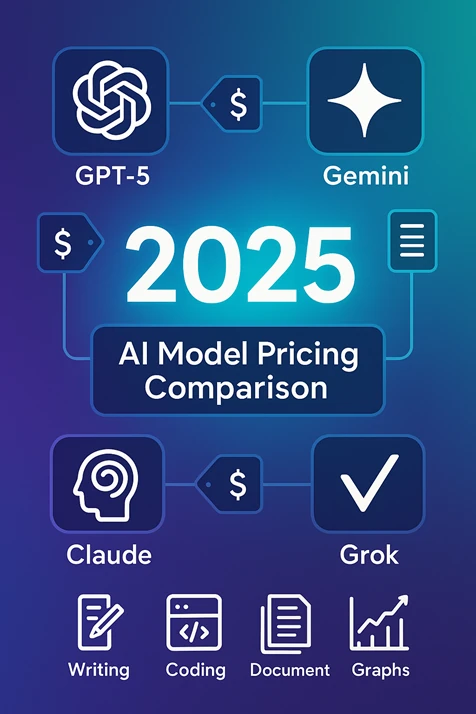AI Model Pricing 2025: GPT‑5, Gemini, Claude, Grok, Use Cases & Sentiment
Estimated reading time: 19 minutes
Table of Contents
- Introduction: Why AI Model Pricing Comparison Matters in 2025
- Frontier Model Landscape: GPT‑5, Gemini 2.5, Claude 4, Grok, and Open-Source
- AI Model Pricing Comparison: Tiers, Token Costs, and Context Windows
- Context Window Comparison: Long Context, RAG, and Real-World Workflows
- Best-Fit Niches: Selecting the Right AI Model by Task
- Model Selection Guide: A Practical Decision Tree
- Retrieval-Augmented Generation (RAG) vs. Long Context Approaches
- Performance: Latency, Throughput, and Cost Optimisation
- Frontier, Mid, and Fast Tiers: Where to Spend and Save
- GPT‑5 Market Sentiment: Real-User Experiences (August 2025)
- Cost Forecasting: Build a Model Budget for 2025
- Provider Portability & Abstraction Layers: Futureproofing Your AI Stack
- Case Studies: Winning Model Mixes for Real Workloads
- Evaluation and Monitoring: How to Keep Quality High
- Australian Context: Privacy, Data Residency, and Compliance Nuances
- FAQ: AI Model Pricing, Selection, and Best Practice
- Get Custom Model Advice: Lyfe AI Enterprise Solutions
- Closing Thoughts
Introduction: Why AI Model Pricing Comparison Matters in 2025
The surge in generative AI means AI model pricing in 2025 is on every CTO and builder’s radar. With GPT‑5, Gemini 2.5, Claude 4, and Grok, plus rapid advances in open-source, picking the right model is as much about fit and context window as pure cost. This guide provides a comparison table, practical decision trees, market sentiment, and real-world deployment advice — so you stay ahead without paying premium rates for average tasks.
Frontier Model Landscape: GPT‑5, Gemini 2.5, Claude 4, Grok, and Open-Source
- GPT‑5: Standout for general-purpose reasoning, assistant tasks, and enterprise workflows, building on fast vs. “thinking” automatic routing.
- Gemini 2.5 (Pro/Flash): Excels at long-context, multimodal work (text, images, video), and Google ecosystem integration.
- Claude 4 (Opus/Sonnet/Haiku): Instruction following, agentic coding, and highest trust for multi-step writing or refactoring.
- Grok 3: Specialises in advanced maths, problem solving, and rapid-fire Q&A, especially when leveraging real-time X data streams.
- Open-Source Leaders: Mixture-of-experts and RAG-optimised models stand in for privacy, classification, or niche language tasks.
AI Model Pricing Comparison: Tiers, Token Costs, and Context Windows
| Model | Input Cost (per 1M tokens) |
Output Cost (per 1M tokens) |
Max Context Window | Best Fit Use Cases |
|---|---|---|---|---|
| GPT‑5 | $1.25 | $10.00 | ~400k–1M (dynamic) | General Reasoning, Assistants, Safe Business Integration |
| Gemini 2.5 Pro | $1.25 | $10.00 | Up to 2M | Long Documents, Multimodal, Google Stack |
| Claude 4 Opus | $15.00 | $75.00 | Up to 200k | Complex Writing, Agentic Coding, Safety-Critical Work |
| Claude 4 Sonnet | $3.00 | $15.00 | Up to 200k | Mid-Volume, Cost-Effective General Use |
| Grok 3 | $3.00 | $15.00 | Up to 1M | Math/Reasoning, Real-time, Fast Prototyping |
| Open-Source (MoE/RAG-specialist) | $0.10–$1.00* | $0.10–$1.00* | Varies (up to 256k+) | Privacy, Classification, Custom Use Cases |
*Costs for self/managed hosting, excludes hardware, typically lowest for predictable, high-volume tasks.
Context Window Comparison: Long Context, RAG, and Real-World Workflows
- Largest context: Gemini 2.5 and GPT‑5 support document analysis across hundreds of pages.
- Long context caveat: Effective window is always less than headline—too much noise can degrade results.
- When to use RAG: Retrieval-Augmented Generation remains the gold standard for large corpora — it’s precise, efficient, and cost-friendly.
- Best practice: For contracts, knowledge bases, and multi-party emails, index, then retrieve, then summarise, only using long context when essential.
Best-Fit Niches: Selecting the Right AI Model by Task
| Model | Niche #1 | Niche #2 |
|---|---|---|
| GPT‑5 | Conversational Assistants | Enterprise Workflow Automation |
| Gemini 2.5 | Multimodal Content Analysis | Legal & Document Review |
| Claude 4 Opus | Complex Software Engineering | Structured Business Writing |
| Grok 3 | Maths/Problem Solving | Real-time Market Research |
| Open-Source | Privacy-Sensitive Analytics | Domain-Specific Extraction |
Model Selection Guide: A Practical Decision Tree
- Is the task privacy-sensitive? — Use open-source or ensure data-residency controls.
- Is the task high volume/simple? — Use fast/flash or mini tiers for efficiency.
- Deep reasoning needed? — Route to main “think” path of GPT‑5, Claude Opus, etc.
- Does the workflow need images or tables? — Gemini or specialist multimodal model.
- Real-time or X/Twitter data? — Grok 3 or workflow with X integration.
Retrieval-Augmented Generation (RAG) vs. Long Context Approaches
- Embed your documents as vectors, retrieve most relevant for every query (RAG) — typically highest accuracy/cost balance.
- Chunk and layer context: Short summary, deep dive, and minimal redundancy gives best results.
- RAG is the go-to for ongoing or multi-turn Q&A, and reduces hallucinations vs. feeding large, raw context windows.
Performance: Latency, Throughput, and Cost Optimisation
- Short prompts and targeted summaries decrease both latency and spend.
- Stream responses, especially for UIs and chatbots, to reduce user wait time.
- Batch non-interactive work; parallelise API calls for research or bulk QA.
- Cache top prompts, system instructions, or moderation flows for reuse.
Frontier, Mid, and Fast Tiers: Where to Spend and Save
- Frontier tiers (GPT‑5, Claude Opus, Gemini Pro) — For complex, multi-step, or long-form tasks.
- Mid tiers (Claude Sonnet/Haiku, Gemini Flash, GPT‑5 Mini) — For day-to-day productivity, support, and coding.
- Fast/flash tiers — Use for massive classification, summarisation, and real-time decision systems.
- Mix-and-match: Route by task complexity, budget, and context window to prevent waste and get ideal speed/price.
GPT‑5 Market Sentiment: Real-User Experiences (August 2025)
- Positive: Users report faster interactions, fewer hallucinations, and convenience from auto “think” vs. “fast” switching.
- Incremental, not radical: Upgrade feels like a well-tuned tool rather than an AGI leap.
- Mixed coding reviews: Strong for all-round dev, but Claude Opus remains favourite for deep refactor/complex agentic tasks.
- Verification friction: Business/ID verification adds a hurdle for smaller devs/startups—larger enterprises less affected.
Cost Forecasting: Build a Model Budget for 2025
- Estimate input/output tokens per request per workflow (see your logs for baselines).
- Multiply by vendor token cost, add 10–20% margin for retries/expansion/tool use.
- Route non-critical tasks to mid/fast tiers to keep spend manageable.
- Forecast for bursts, pilot workloads, and always keep “runway” for new use cases.
Provider Portability & Abstraction Layers: Futureproofing Your AI Stack
- Use an API gateway or abstraction layer so you can swap models, route per task/policy, and test each vendor’s capabilities.
- Automate QA to alert on performance/quality drops with any update.
- Design for tool/library compatibility (i.e., use industry standards for prompts, context, and APIs).
- Ensure privacy, compliance docs, and process will map across models (especially for audits).
Case Studies: Winning Model Mixes for Real Workloads
Support Copilot
- Fast/Flash model for intent classification + article retrieval.
- Frontier model step-up for complex or dissatisfied queries.
Coding Assistant
- Mid-tier for completions, explanations, and refactor proposals.
- Frontier tier just for architecture or legacy code review.
Enterprise Research Assistant
- RAG over private, document-indexed knowledge base + summarisation layer.
- Frontier or Gemini/Claude for cross-document, context-rich analysis.
Evaluation and Monitoring: How to Keep Quality High
- Define golden sets — pre-verified Q&A/test prompts for weekly regression checks.
- Track token cost per task, hallucination rate, quality KPIs.
- Run drift checks after model/prompt changes; alert and rollback if quality drops.
- Engage real users for ongoing feedback and continuous improvement.
Australian Context: Privacy, Data Residency, and Compliance Nuances
- Australian Privacy Principles classify biometrics as sensitive — always get informed, explicit consent.
- Ask vendors about data residency in Australia if required; check regional support in APIs.
- Keep DPIA/PIA, consent, and cross-border transfer documentation current.
FAQ: AI Model Pricing, Selection, and Best Practice
Which AI model is best for long-context document review?
How do I forecast costs for different models?
Can I use more than one model in my workflow?
What’s the difference between RAG and using a long-context model?
What if my volume spikes suddenly?
Are open-source models a real option for business?
How does “auto reasoning” in GPT‑5 work?
Should I prioritise price or model accuracy?
Do all vendors require ID verification for top models?
How do I make my stack futureproof?
Get Custom Model Advice: Lyfe AI Enterprise Solutions
Lyfe AI delivers custom, domain-specific AI models for company or industry-specific use—plus advice on pricing, privacy, and stacking best-fit models for cost, compliance, and reliability. For a tailored solution, email human@lyfeai.com.au.
For subscription management: https://dashboard.stripe.com/login.
Closing Thoughts
AI model pricing in 2025 is more competitive—and more nuanced—than ever. Whether you’re scaling support, building enterprise workflows, or piloting new ventures, the mix of GPT‑5, Claude, Gemini, Grok, and open-source gives you unprecedented choice. Build for abstraction, forecast for change, and always tune for quality—this is the blueprint for sustainable, cost-effective AI adoption.



